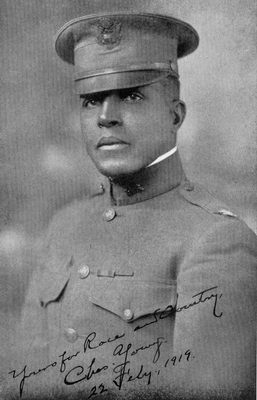Omega Spotlight
Colonel Charles Young
Born Saturday, March 12, 1864
Died Sunday, January 8, 1922
Colonel Charles Young was born Saturday, March 12, 1864 in Mayslick, Kentucky from ex-slaves. He graduated from high school at the age of 16, and won placement to West point.
 In 1889, he graduated from West Point as a commissioned Second Lieutenant. He was its 3rd Black graduate. In 1894, he was appointed Professor of Military Science at Wilberforce University. Colonel Young was a member of the Buffalo soldiers in the 9th and 10th Calvary. In 1903 with the 10th Calvary, he extended the roads in Sequoia National Park in California. Colonel Charles Young was also one of the first Military Spies for the Military Information Division in Haiti.
In 1889, he graduated from West Point as a commissioned Second Lieutenant. He was its 3rd Black graduate. In 1894, he was appointed Professor of Military Science at Wilberforce University. Colonel Young was a member of the Buffalo soldiers in the 9th and 10th Calvary. In 1903 with the 10th Calvary, he extended the roads in Sequoia National Park in California. Colonel Charles Young was also one of the first Military Spies for the Military Information Division in Haiti.
Colonel Charles Young was made the second honorary member of the Omega Psi Phi Fraternity, Incorporated on March 8, 1912. He spoke at the 8th Grand Conclave in Boston. He delivered his speech “The Reconstruction” to an audience of 10,000.
For his service as adviser to the Liberian Government and his supervision of the building of the country's infrastructure, he was awarded the NAACP’s second Springarn Medal in 1916.
While fighting in the Philippines, he was promoted to Captain. He served in Haiti and Liberia. He became the first black Major in the U.S. Army. Under General John Pershing, he chased the outlaw-hero Pancho Villa, back into Mexico. "Black Jack" Pershing recommended that Young be promoted to General. He would have been America's first black General. The recommendation was denied. However, while serving in the military, Young mentored Sergeant Major Benjamin O. Davis. Davis would go on to become the Army's 1st Black General.
When World War I started, Young was the highest ranking black officer. As such, the Army rejected him for active service On June 22, 1917. They forced him to retire saying he had high blood pressure which was a cloak for bigotry and racism. In June of 1918, in response to show he was fit, Young saddled his mare Dolly, and rode 500 miles from Xenia, Ohio to Washington D.C. to the Old Executive Building at 1730 Pennsylvania Avenue to see the Secretary of War, Lindley Garrison, to petition for reinstatement. As a result, he was promoted to full colonel and reassigned to Camp Grant, Illinois. He was later reassigned back to Nigeria. He didn't get a chance to fight in WWI.
He died on a mission in Lagos, Nigeria from Bright's Disease on Sunday, January 8, 1922. His funeral was one of the few ever held at Arlington National Cemetery. He is buried there in section 3. The program of Memorial Day originated from the laying of the wreath in his honor.
Young was devoted to his wife Ada and their two children, Charles Jr. and daughter Marie. His hobbies included playing many instruments from the flute to the harp and he composed 103 short poems. He spoke several languages.
Colonel Young's home in Ohio is the home of the National Museum of African American Military History. In the past, the house was a way station on the Underground Railroad. The house is currently owned and maintained by Omega Psi Phi Fraternity, Incorporated.
See our list of featured Omega Men